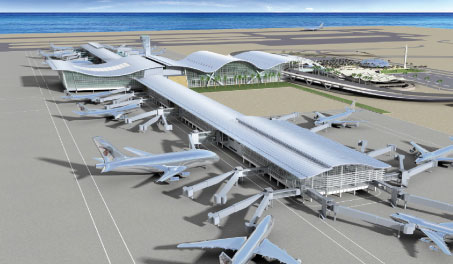
The design focus has been on the creation of a spacious, but efficient and convenient airport experience – arched columns, skylights and highlighted finishes are being used to enhance the feeling of space.
Premium terminal facilities, operational efficiency and passenger convenience will be key elements of the new airport experience. Opening day capacity will be 24 million passengers – 30 times the current population of Doha. At its ultimate development in 2015, NDIA will be able to handle 50 million passengers, two million tonnes of cargo and 320,000 movements. In short, it will be three times the size of the existing Doha airport and six times the capacity. The 350,000sqm passenger terminal will be the largest building in Doha, covering an area equivalent to 50 football pitches. A total of 22 square kilometres of land is being reclaimed for the project, which requires nearly 13km of armoured seawall for protection. Around 50% of this area has to be reclaimed from the open sea.
HOK designed the new airport, while Bechtel is providing engineering, project management and construction management services. The undulating wave shape of the passenger terminal is one element of a water-themed environment designed to complement the airport’s location alongside the Arabian Gulf. NDIA, which will become the new hub for Qatar Airways, has been designed specifically to handle the A380; when fully developed it will be able to handle six A380s simultaneously.
IT systems integration
A consortium of ARINC and Thales was awarded the $75 million (€53m) contract for IT, security, and telecommunication systems at the New Doha International Airport. ARINC will equip the airport with a comprehensive suite of advanced passenger processing systems and related technologies, including ARINC iMUSE Common Use Terminal Equipment (CUTE) at more than 100 check-in counters and departure gates. ARINC will also build the information exchange backbone for data flowing across the new airport’s applications, systems, users, and facilities. Thales will implement the safety and security system, the Local Area Network (LAN) and the Network Management. Both companies will jointly provide extensive project design and management.
The design focus has been on the creation of a spacious, but efficient and convenient airport experience – arched columns, skylights and highlighted finishes are being used enhance the feeling of space. The emphasis is on an effortless passenger experience; all passenger transfers will occur under one roof, with short walking distances between gates and shorter connection times between flights.
Economic development
NDIA will be a cornerstone for economic development, playing a critical role in maintaining Qatar’s position as one of the world’s fastest growing economies. With Doha’s current airport facing increasing congestion, the new airport will replace the current facility with much larger cargo and passenger facilities, providing an important transport hub to fuel the country’s ongoing development.
Energy conservation
The passenger terminal curtain walls are coated to reduce solar exposure, the roof overhang provides shade and the roof is insulated. The mechanical systems include CO2 sensors to regulate air intake based on occupancy; the electrical system has daylight monitoring and occupancy sensors. The landscaping uses desert-adopted species and irrigation water from recycled waste water.
Insulation and low reflective materials will be key features and each façade will be made up of high performance glazing, with significant insulation used on the glazing on the south, east and west facades. Even non-glazed walls will be highly insulated. Inward angled curtain-wall facades from the roof overhang to the ground level will help reduce solar exposure to visitors and internal terminal areas, reducing the need for internal cooling.







